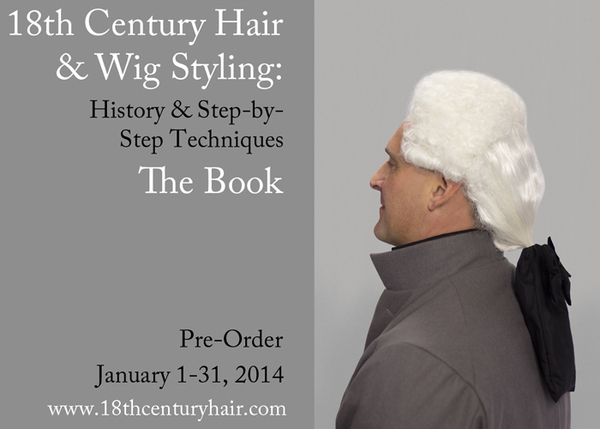More information about the 18th C. Hair & Wig Styling Book, currently open for pre-orders (until Jan. 31):
Some people have asked what’s going on in terms of men’s hair (and wigs) in the book.
First, I’ve considered men’s hair/wigs equally with women’s in terms of the history portion of the book. So if you’re interested in why men wore wigs and powder, how they styled their hair & wigs, and what styles are appropriate to which era, all of that will be included.
For the step-by-step styles, where I show you exactly how to style hair and wigs into 18th c. appropriate styles, I’ve chosen to do only three men’s styles. This is for a couple of reasons:
- I think that the primary market for this book will be women. Modern women tend to be more interested in hairstyles than men. We all know that it’s often harder to get boys into historical hairstyles and wigs.
- While there was a wide variation of men’s hairstyles across the century, it’s the queue styles (wigs/styles with a ponytail) that were overall the most popular in the era — from the 1730s through the 1790s — and those are the styles most modern costumers and reenactors want to wear, and the styles most commonly chosen by theater/film designers.
So what I’ve chosen to do is to focus in on the queue hair/wig styles, showing you:
- Which design elements are appropriate to which era — so if you’re doing a 1740s queue hairstyle or wig, there will be some differences from a 1780s hairstyle or wig. How do you recognize them, and how do you STYLE them? All that info will be included.
- Which design variations are available to you — how to mix up the queue style so that you’re not always wearing the same style, or that various men within your unit/production are wearing different styles. What can you do besides the basic ponytail? What can you do with the hair on top? Here’s a hint: there’s tons of options!
An important note is that in the 18th century, even if a man didn’t wear a wig (and most English and French men did), he still styled his hair exactly the same, design-wise. So all of this information applies, even if you (or the men you dress) aren’t into wearing wigs!
Down the line, IF this book is successful, I’m thinking I could publish a shorter supplement with more/new hair/wig styles. In that case, I can show you how to make a full-bottom wig, bob wig, and some of the many other men’s styles of the era. But for now, the book will focus on the queue (ponytail) wig.
Pre-Order Update
Pre-orders are going well, but I still have a long way to go to be able to afford to print this book! If you’d like this book to exist, please pre-order now — it will save you some money, and ensure that the book happens!
Reminder: you have until January 31 to pre-order!
